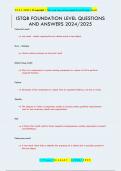2 0 2 4 /2025 | © copyright | This work may not be copied for profit gain Excel!
ISTQB FOUNDATION LEVEL QUESTIONS
AND ANSWERS 2024/2025
False-fail result
→ test result - defect reported but no defect exists in test object
Error - Mistake
→ Human action produces an incorrect result
Defect (bug, fault)
→ Flaw in a component or system causing component or system to fail to perform
required function.
Failure
→ Deviation of the component or system from its expected delivery, service or result.
Quality
→ The degree to which a component, system or process meets specified requirements
and/or user/customer needs and expectations.
Risk
→ A factor that could result in future negative consequences; usually expressed as impact
and likelihood.
False-pass result
→ A test result which fails to identify the presence of a defect that is actually present in
the test object.
1|Page| GradeA+ | 2 0 0 2 5
,2 0 2 4 /2025 | © copyright | This work may not be copied for profit gain Excel!
Testing
→ Also know as evaluation. The process consisting of all life-cycle activities both static
and dynamic, concerned with planning, preparation, and evaluation of software
products and related work products to determine that they are fit for purpose and to
detect defects.
Requirement
→ A condition or capability needed by a user to solve a problem or achieve an objective
that must be met or possessed by a system or system component to satisfy a contract,
standard, specification, or other formally imposed document.
Review
→ An evaluation of a product or project status to ascertain discrepancies from planned
results and to recommend improvements. Examples include management review,
informal review, technical review, inspection, and walkthrough.
Debugging
→ The process of finding, analyzing, and removing the causes of failures in software.
Confirmation testing (re-testing)
→ Testing that runs test cases that failed the last time they were run, in order to verify the
success of corrective actions.
Test Strategy
→ A high-level description of the test levels to be performed and the testing within those
levels for an organization or program (one or more projects)
Test Execution
→ The process of running a test on the component or system under test, producing actual
results
1|Page| GradeA+ | 2 0 0 2 5
,2 0 2 4 /2025 | © copyright | This work may not be copied for profit gain Excel!
Test approach
→ The implementation of the test strategy for a specific project.
Test Plan
→ A document describing the scope, approach, resources, and schedule of intended test
activities. It identifies among others test items, the features to be tested, the testing
tasks, who will do each task, degree of test independence, the test environment, the
test design techniques, and entry an exit criteria to be used, and the rationale for their
choice, and any risks requiring contingency planning. It is a record of the test planning
process.
Test monitoring
→ A test management task that deals with the activities related to periodically checking
the status of a test project. Reports are prepared that compare the actuals to that
which was planned.
Test condition
→ An item or event of a component or system that could be verified by one or more test
cases, e.g. a function, transaction, feature, quality attribute, or structural element.
Test basis
→ All documents from which the requirements of a component or system can be inferred.
the documentation on which the test cases are based. If a document can be amended
only by way of formal amendment procedure, then the test basis is called a frozen test
basis.
Test Data
→ Data the exists before a test is executed, and that affects or is affected by the
component or system under test. Example - in a database
Coverage (test coverage)
1|Page| GradeA+ | 2 0 0 2 5
, 2 0 2 4 /2025 | © copyright | This work may not be copied for profit gain Excel!
→ The degree, expressed as a percentage, to which a specified coverage item has been
exercised by a test suite.
Test procedure specification (test procedure, test script, manual test script)
→ A document specifying a sequence of actions for the execution of a test.
Test Suite
→ A set of several test cases for a component or system under test, where the post
condition of one test if often used as the precondition for the next one.
Incident
→ Also known as deviation. Any event occurring that requires investigation.
Testware
→ Artifacts produced during the test process required to plan, design, and execute tests,
such as documentation, scripts, inputs, expected results, set-up, and clear-up
procedures, files, databases, environment, and any additional software or utilities used
in testing.
Regression testing
→ Testing of a previously tested program following modification to ensure that defects
have not been introduced or uncovered in unchanged areas of the software, as a result
of the changes made. It is performed when the software or its environment is changed.
Exit Criteria
→ The set of generic and specific conditions, agreed upon with the stakeholders, for
permitting a process to be officially completed. The purpose of exit criteria is to
prevent a task from being considered completed when there are still outstanding parts
of the task that have not been finished. Exit criteria are used to report against and to
plan when to stop testing.
1|Page| GradeA+ | 2 0 0 2 5




